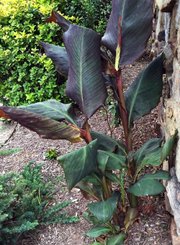Q On Oct. 3 a reader asked about over-wintering angel wing begonias. Yes, they do look very pretty right before the first hard freeze. But they drop flowers every day, which is a real pain when they're in the house. I finally realized I am much happier buying new ones in the spring than cleaning up after them all winter.
A The same thing could be said for Boston ferns, tropical hibiscus and others. But for those who don't mind vacuuming, the plants should be inside now. If you wait until a killing frost, they will shed even more, since they will have been exposed to some pretty low temperatures.
Q The red "surprise" lilies that are in bloom now and have been for a week -- the leaves come out of the ground at a different time -- when do you dig and transplant them? I want to rescue some from an old, abandoned homesite. The red flowers are on a single stem, and the flowers are quite intricate in shape.
A The red surprise lilies are Lycoris radiata. Their foliage will appear soon after the blooms are finished and should remain intact throughout the winter. In late spring, the foliage dies down and the bulb remains dormant until early to midfall when the naked stem appears with the blooms, and the cycle repeats. You can dig the bulbs when the foliage first appears in the fall or in late spring as the leaves begin dying back. Sometimes in a hard winter, the foliage does get damaged and we go a year without blooms. Surprise lilies might also pay you back for moving them and not bloom for a year or two. But salvage some and see what happens.
Q I live in Rogers and have a zoysia grass lawn. We have a sprinkler system but turned it off about Oct. 1 when the grass stopped growing. It hasn't been mowed since then. Since we've had no rain in the last six weeks, should we turn the system back on? I know my sister in Little Rock is still watering four days a week. Even if we continue watering, I don't think it would induce the grass to start growing again.
A I am watering weekly as well and praying for rain. I would assume you have shrubs in addition to a zoysia lawn, and while they may not do much growing in October, they still need water. We were at 92 degrees recently, and I am mowing every two to three weeks. I turn off my sprinkler after a killing frost.
Q We bought a camellia sasanqua bush two years ago. It had beautiful pink blooms the past two falls. This year it seems to be dying. Half the bush seems dead, and the other is green with buds forming as it has in the past. What could be wrong? Is it too late to save?
A With half the bush dying or dead, it doesn't sound good. When did it begin to die back? If it is setting flower buds on the living side, enjoy the flowers this winter and wait until spring, to prune out the dead, shape what is left and see what happens. Did you water this summer and fall? Did anything damage the side that is having problems? Do you see any signs of scale insects? You can take a sample of the dying part to your local county extension office for a diagnosis. Before we know what is causing the problem, we can't suggest a solution.
Q I need some help in rooting small bushes and plants. I can't root anything. I snip cuttings about 6 inches long, and I've tried putting them in water with no luck. I've bought root hormone, and it doesn't work either. I've tried getting cuttings at different times of the year, mainly in the spring. What am I doing wrong? I would really like to root cuttings from a Japanese maple, a gardenia and a camellia that I have growing in my yard.
A Timing could be part of the problem, and also the type of plants you are trying to root. Some plants root at the drop of a hat, while others can be a bit more finicky. For most woody plants, cuttings taken in mid- to late June through early July are the easiest to root. The stems have had a chance to harden off from new spring growth, but they aren't overly woody. The woodier the cutting is, the longer it will take to root. Take cuttings that are 3 to 4 inches long. Strip off any foliage at the base of the cuttings. Get a pot and fill it with fresh, sterile potting soil that has been moistened to the consistency of a wrung-out sponge. Put in your cuttings. Use rooting hormone if you have some. Then place the pot with the cuttings inside a clear plastic bag. Put it in a bright window indoors but out of direct sunlight. Be patient. You have just created a mini-greenhouse to keep the humidity up while rooting takes place. With woody cuttings, that can take months -- especially during the cooler months. Leave the cuttings sealed up for a month or two and then check what has happened.
Q Here's a photo of a plant that popped up this spring. Any idea what it is?
A It looks like a dark-leafed variety of canna. Some folks are growing them more for their unusual foliage than their flowers. I suspect a dark flower accompanies this one.
Janet B. Carson is a horticulture specialist for the University of Arkansas Cooperative Extension Service. Write to her at 2301 S. University Ave., Little Rock, Ark. 72204 or email her at
jcarson@arkansasonline.com
HomeStyle on 10/24/2015

